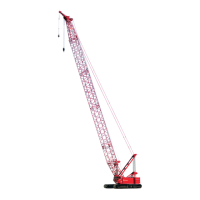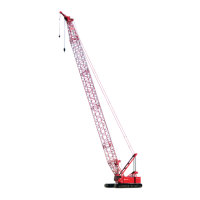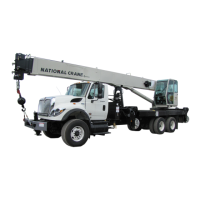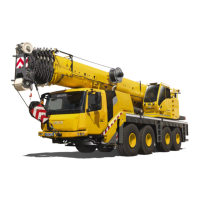INTRODUCTION 14000 SERVICE MANUAL
1-32
Published 09-10-14, Control # 065-24
Node 4 controller sends a variable 0 to 24 volt output that is
divided by resistors and applied to selected travel pump
EDC. Node 3 controller sends a 24 volt output to enable
travel brake release solenoid HS-15 and release selected
crawler brake, before travel pump(s) strokes.
Travel pump EDC tilts selected pump swashplate in reverse
direction. Hydraulic fluid flow is from left travel pump outlet A
and right travel pump outlet B, through diverter valve (left
travel flow only), through swivel to left travel motor inlet port
and right travel motor inlet port. Return fluid is from motor
outlet ports to pump inlet ports.
Node 4 controller input voltage to travel pump EDC is relative
to control handle movement. As selected travel control
handle is moved to neutral position, node 1 controller
compensates for hydraulic system leakage or changing
engine speed. Node 4 controller sends a zero output voltage
to pump EDC to move swashplate to center position. After
travel control handle command is off for a preset time, node 3
controller sends a zero output voltage to disable travel brake
solenoid HS-15. Travel brake valve shifts to block pilot
pressure to brakes and opens a line to tank. Brakes apply.
Two-Speed Travel Operation
Travel two-speed switch allows operator to select low speed
when smooth starts and precise control over the load is
required. Low speed places travel motor in maximum
displacement (high torque, low speed) position and prevents
motor from shifting to high speed. When travel two-speed
switch is in low speed position, node 3 controller sends a 24
volt output to enable two-speed travel solenoid HS-16,
shifting valve and directing hydraulic pilot pressure to P/C
(pressure/ compensated) valve. The P/C valve shifts ECOR
(electric compensated over-ride) spool placing travel motor
in maximum displacement (high torque, low speed) position.
Travel motors remain in this position until travel speed switch
is placed in high speed position and engine speed is more
than 1,500 RPM.
Place travel two-speed switch in high speed when maximum
available travel speed is required (normal operation).
Hydraulic pressure required for releasing travel two-speed
solenoid valve is from drum 3/left travel diverting charge
pump at approximately 350 psi (24 bar). When travel two-
speed switch is in high speed position, travel motors shift to
minimum displacement (low torque, high speed)
automatically if engine speed is above 1,500 RPM and
system pressure is below 3,915 psi (270 bar). If engine is
below 1,500 RPM, two-speed travel solenoid HS-16 is
enabled although travel two-speed switch in the high
position. Travel two-speed solenoid HS-16 is disabled,
shifting valve and removing hydraulic pilot pressure to P/C
valve, allowing motor to operate in ECOR mode.
Travel Cruise
When travel cruise switch is moved to cruise position, an
input signal is sent to node 1 controller. Node 4 controller
sends a constant output signal to travel pumps to lock-in
selected flow requirements and direction.
Moving travel cruise switch to off position or moving either
travel handle in opposite direction from neutral sends an
input signal to node 1 controller. Node 4 controller sends an
output signal to travel pumps to open travel cruise circuit and
return control of travel system to operator.
